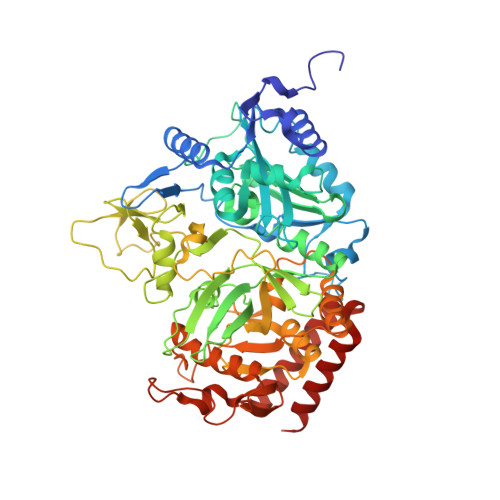Differential Inhibition of Cytosolic PEPCK by Substrate Analogues. Kinetic and Structural Characterization of Inhibitor Recognition.
Stiffin, R.M., Sullivan, S.M., Carlson, G.M., Holyoak, T.(2008) Biochemistry 47: 2099-2109
- PubMed: 18197707
- DOI: https://doi.org/10.1021/bi7020662
- Primary Citation of Related Structures:
2RK7, 2RK8, 2RKA, 2RKD, 2RKE - PubMed Abstract:
The mechanisms of molecular recognition of phosphoenolpyruvate (PEP) and oxaloacetate (OAA) by cytosolic phosphoenolpyruvate carboxykinase (cPEPCK) were investigated by the systematic evaluation of a variety of PEP and OAA analogues as potential reversible inhibitors of the enzyme against PEP. The molecules that inhibit the enzyme in a competitive fashion were found to fall into two general classes. Those molecules that mimic the binding geometry of PEP, namely phosphoglycolate and 3-phosphonopropionate, are found to bind weakly (millimolar Ki values). In contrast, those competitive inhibitors that mimic the binding of OAA (oxalate and phosphonoformate) coordinate directly to the active site manganese ion and bind an order of magnitude more tightly (micromolar Ki values). The competitive inhibitor sulfoacetate is found to be an outlier of these two classes, binding in a hybrid fashion utilizing modes of recognition of both PEP and OAA in order to achieve a micromolar inhibition constant in the absence of direct coordination to the active site metal. The kinetic studies in combination with the structural characterization of the five aforementioned competitive inhibitors demonstrate the molecular requirements for high affinity binding of molecules to the active site of the enzyme. These features include cis-planar carbonyl groups that are required for coordination to the active site metal, a bridging electron rich atom at the position corresponding to the C2 methylene group of OAA to facilitate interactions with R405, a carboxylate or sulfonate moiety at a position corresponding to the C1 carboxylate of OAA, and the edge-on aromatic interaction between a carboxylate and Y235.
- Department of Molecular Biosciences, The University of Tennessee Health Science Center, Memphis, Tennessee 38163, USA.
Organizational Affiliation:



















